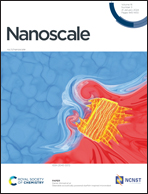Large area arrays of discrete single-molecule junctions derived from host–guest complexes†
Abstract
The desire to continually reduce the lower limits of semiconductor integrated circuit (IC) fabrication methods continues to inspire interest in unimolecular electronics as a platform technology for the realization of future (opto)electronic devices. However, despite successes in developing methods for the construction and measurement of single-molecule and large-area molecular junctions, exercising control over the precise junction geometry remains a significant challenge. Here, host–guest complexes of the wire-like viologen derivative 1,1′-bis(4-(methylthio)-phenyl)-[4,4′-bipyridine]-1,1′-diium chloride ([1][Cl]2) and cucurbit[7]uril (CB[7]) have been self-assembled in a regular pattern over a gold substrate. Subsequently, ligandless gold nanoparticles (AuNPs) synthesized in situ are deposited over the host–guest array. The agreement between the conductance of individual mono-molecular junctions, appropriately chosen as a function of the AuNP diameter, within this array determined by conductive probe atomic force microscope (c-AFM) and true single-molecule measurements for a closely similar host–guest complex within a scanning tunneling microscope break-junction (STM-BJ) indicates the formation of molecular junctions derived from these host–guest complexes without deleterious intermolecular coupling effects.



 Please wait while we load your content...
Please wait while we load your content...